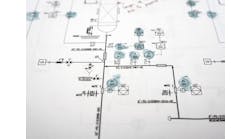This Control Talk column appeared in the July 2019 print edition of Control. To read more Control Talk columns click here or read the Control Talk blog here.
Greg: Split-ranged control valve applications are particularly challenging. Here, we look at the many sources of the problems and the innovative solutions possible using the functionality of today’s PID. To address this, we have enlisted the help of great leaders in maximizing the functionality of the PID. We start with George Buckbee, who has considerable experience in process control and is currently an outstanding source for getting the most out of your PID, as seen in his many presentations and papers. George is an ISA Fellow and author of the focused book, “Mastering Split Range Control.” He heads up the Performance Solutions group at Metso. We then move on to seek a creative, relatively unknown approach form Nick Sands, DuPont senior manufacturing technology fellow and ISA Fellow, who was inducted this year into the Control Process Automation Hall of Fame. Nick has been advancing our profession by involvement in the International Society of Automation. He was the 2015-2016 vice president of the ISA Standards and Practices Department and co-chair of ANSI/ISA-18.2-2016, “Management of Alarm Systems for the Process Industry.” Nick and George are leading participants in a new ISA Standards Committee to develop an ISA Technical Report on PID Algorithms and Performance.
George: First, we should mention that split-range control refers to a situation where two final control elements are managed by a single controller. Usually, different fluids flow through each of two valves, for example, steam and cooling water, or acid and base. Split-range is often misapplied to the common situation where a large valve and a small valve supply different amounts of the same fluid. That situation is better handled by other strategies, such as mid-ranging or coarse-fine control.
Greg: What are sources of oscillations, and what are some of solutions?
George: In many systems, the valves are configured or calibrated so that there will be a small gap between valve actuation. For example, the cooling valve may close at 49% control output signal, and the heating valve starts to open at 51%. As with any form of gap controller, it is common to oscillate back and forth across the gap. In the case of split-range control, the oscillation may be further exacerbated by the fact that many valves do not come smoothly off their seats from fully closed to small openings. In some processes, the oscillation may be acceptable. However, if the process demands smooth control through the transition point, there are a few strategies:
For tight control at the setpoint, overlap the transition point. For example, the cooling valve can remain open from 0-51% of output, and the heating valve can start opening at 49% through to 100%. You lose a little efficiency between 49% and 51%, but ensure a smoother transition. Note, however, that there can be significant process issues, depending on the two fluids used (i.e. steam and water). So, be sure to consult with the process engineer before choosing this technique.
Also, use a sensitive actuator and valve designed for throttling with a smart positioner. Smart positioners can greatly improve a good valve’s response. Some positioners have algorithms to address the inherently nonlinear valve characteristics that happen as the valve comes off the seats. A positioner will also help to overcome mechanical issues like deadband and stiction.
Another option is to eliminate controller integral action near the transition point. The controller will operate with some small amount of offset from the setpoint, but you will greatly reduce the oscillation.
It’s particularly important to minimize nonlinearities. Aside from the nonlinearities at valve opening, there is one other major nonlinearity: the process gain differences over the range of operation. Dead time and time constant may also differ. It can be extremely difficult to size the two valves so that the process gain remains constant across the full range of operation. You can compensate for this in several ways. You can select controller tuning according to the valve with the larger process gain, effectively detuning the loop. A better solution is to add a signal characterizer to compensate for the nonlinear installed characteristic, do response testing and develop dynamic models for each valve, writing the resulting tuning settings to the PID. If the PID does not facilitate bumpless writing to tuning settings, you may need to momentarily put the controller in manual.
Nick: In the old days, split-range control was done with a single output signal to two valves, and the valves, or I/Ps, were calibrated to operate so one valve would close from 0-50%, and the other valve would open from 50-100%. Usually, both valves were closed, or close to it, at 50%, as George described. Later, each valve was given an output signal and the split was done in the control system, still 0-50% and 50-100%. But independent signals allowed for the possibility of different control.
The single controller suffers from disadvantages that George mentioned, the same gain used for each valve, same response time used for each valve, and oscillations and waste associated with oscillations at the split, as well as the controller output of 0-100% not corresponding directly to percent-open of the valve in the HMI, which is a human factors issue. The split could be modified to account for differences in controller gain (e.g., 0-25% and 25-100%). This was tricky to maintain and sometimes understand.
Greg: How did you eliminate split range?
Nick: It might seem like a good idea to use the same process variable to two different controllers, one for each valve. Two controllers would allow for each controller output of 0-100% to correspond to the percent-open of the associated valve, independent gain for each controller and valve, independent response time (integral and derivative) for each controller and valve and reduced oscillations at the split. However, this solution without additional intelligence leads to the controllers fighting each other and both valves open at the same time. An offset in the setpoint could help reduce the fighting.
With nicely developed PID control algorithm, we can make the two-controller solution much better. I call it one directional control (ODC).
ODC is a technique for coordinating multiple controllers by limiting control action. Think of ODC as half automatic mode: A controller will respond to process variable changes in one direction as if in automatic, but not respond to process variable changes in the other direction as if the controller were in manual. Another way to think of ODC is by comparison to cascade control: Cascade loops are PIDs in series, one cascading to the other. ODC can use PIDs in parallel, often responding to the same process variable.
For example, using PT101, PIC101A controls PV101A to add nitrogen to the vapor space of a tank, and PIC101B controls PV101B to vent the tank pressure to a vent header. The controllers are coordinated so if either valve is open beyond a set limit, it sends a signal to the other valve, preventing an increase in controller output. This will result in only one valve being open at a time, and only one of the two controllers responding to a change. If the output of PIC101A is greater than 0% (or x%), then it would limit PIC101B from increasing the output. This is done differently in different control systems, but a general way is to set the controller high output limit to the current value.
For each change in pressure, controller PIC101A responds. Controller PIC101B would be constrained to a high output limit of 0% (or y%). Once PIC101A closes to 0% (or x%), the constraint on PIC101B is removed and PIC101B takes control, and when the output is greater than 0% (or x%), PIC101A is constrained to a high output limit of 0% (or y%).
The limits on the valves can be set to minimize the effect of a valve first opening. And the other tricks you mentioned, like characterization, can also be used. To simplify things for the operator, the mode and setpoint can be sent from PIC101A to PIC101B, so they can interact primarily as one controller. An offset can be put between the controller setpoints to minimize oscillations, which equal waste. The controllers’ modes can be set independently for interlock functions as well.
Some DCS have ODC capability essentially built-in, with flags that limit controller action in one direction; some require limit logic to be configured. The principle is simple: The output limit is set to the last value if the controller is constrained in that direction. For example, if the decrease limit signal is set, then the low output limit would be changed from the default value of zero to the current output. The output must be the same or higher. If the output increases, the limit is raised and again. The low output limit cannot exceed the high output limit, though. If both limits are active, then the output cannot change at all.
For more on ODC, see my articles “Control Solutions on a One-Way Street” (InTech, March 1995) and “Consider One Directional Control” (Chemical Engineering Progress, April 1996).
Greg: Often not realized is that deadband introduced in a PID configuration or a variable-frequency drive (VFD) setup, or from backlash in a control valve, will result in a limit cycle if there are two or more integrators in the control loop. Integral action can occur in many important processes (e.g., gas pressure control, and batch composition, pH and temperature control), digital positioners, and each PID in a cascade control system. Stiction requires only one integrator to develop a limit cycle. Oscillations also break out when actuator or positioner sensitivity is poor (e.g., spool positioners and piston actuators). The good news is the oscillation period and amplitude from deadband and poor sensitivity can be reduced by more aggressive tuning, and the oscillation from a splitter configuration deadband stops when the output is far enough away from the split-range point.
Some companies don’t see the problem because they use control valves designed for throttling. Unfortunately, it’s a more common mistake than realized to see on-off valves posing as throttling valves because the on-off valves look more attractive as they have greater capacity, much less leakage and much lower cost. A digital positioner on these rotary valves gives a false sense of confidence because the actuator shaft position responds to the actuator. Not realized is this feedback and readback is not representative of final control element position due to backlash in shaft-to-stem and in stem-to-ball or disk connections, and stiction from tight shutoff. Right now, control valve specification sheets show capacity and leakage but not linearity, deadband, resolution or response time. The specification sheets, along with the pricing, leads to the wrong choice. I haven’t been able to enlist general support to improve valve specification sheets to include valve response. Some astute users actually require valves meet response requirements, including verification by tests. This will be the subject of a future column by me and George.
The nonlinearity and particularly, the stiction, are worse, as you might expect, near the closed position that is the split-range point. Small valve-drop-to-system-pressure-drop ratios to save energy aggravate the problem. Please, please take the time to read, understand and take to heart “How to specify valves that do not compromise control.” For a more succinct view, see “Is your control valve an imposter?”
To provide tight control with split-ranged valves, I advocate control valves and actuators with the least deadband, best resolution and best sensitivity, using a digital positioner, without integral action, tuned with higher gain action. I also recommend directional move suppression (DMS), which is possible for a PID with true external-reset feedback. Simply putting a setpoint up or down rate limit on an analog output block or via a rate limit block on the splitter bock input, and turning on external-reset feedback (e.g., dynamic reset limit), can slow down the integral action in the direction of unnecessarily crossing the split-range point. Valve action to maintain process performance and safety would not be slowed down. (e.g., coolant valves and vent valves would not be slowed down). For bioreactors, where pH is controlled by manipulating carbon dioxide and sodium bicarbonate, DMS would be set to slow down any increases in the sodium bicarbonate. This is critical for cell health because high sodium concentrations that can easily build up over the week-long batch increase cell osmotic pressure, damaging cell membranes and leading to cell rupture. For more on PID solutions and the power of external-reset feedback, see my Shinskey tribute presentation and paper, “Deep Understanding and Great Achievements in PID Control” and the McGraw-Hill 2019 Process/Industrial Instruments and Controls Handbook Sixth Edition.
The nonlinearity of the installed valve characteristic can be reduced by signal characterization. For a better appreciation of this configuration improvement, see the Control Talk blog, “Unexpected Benefits of Signal Characterizers.” For details on how to achieve linearization, see the Control Talk column, “Why and how to establish installed flow characteristics.” For composition, pH and temperature control, high rangeability flowmeters (e.g., magmeters or Coriolis meters) can eliminate the nonlinearity seen by the primary process loops by the use of secondary flow loops. For vessels, the need for split-range between coolant and steam can, in many cases, be eliminated, along with the problematic phase changes, by using steam injectors with a constant coolant flow to create a utility stream that quickly changes between cold and hot by manipulating steam flow. The PID tuning settings can be automatically updated based on which valve is being manipulated and the resulting changes in process dynamics, including those associated with setpoints and production rates.
What are some parting words of wisdom?
George: You can save a lot of time and frustration by using the right tools. Make use of software to accurately identify process dynamics, provide tuning and diagnose valve issues. Operator training is critical, but often overlooked. Training is especially important for shutdown planning, when these valves may help to isolate the process. For split-range and other “non-standard” control schemes, we must be sure to provide training and documentation to the operator.
Nick: Get to know your PID algorithms and put them to work for you. And then document any of the tricks you use so that the next automation engineer can follow your work.
Greg: Next month, George and Nick will discuss the use of valve position control and cascade control to improve loop and process performance without split-ranged controllers.
(10) Thank-you for not knowing oscillations are limit cycles.
(9) Thank-you for piston actuators with link-arm, rack and pinion, and scotch yoke connections.
(8) Thank-you for pinned or key lock instead splined actuator shaft-to-stem connections.
(7) Thank-you for spool-type positioners.
(6) Thank-you for rotary valves designed for least leakage.
(5) Thank-you for valve suppliers who don’t test for backlash or stiction below 20% position.
(4) Thank-you for rangeability definitions that are clueless.
(3) Thank-you for people not having the time to read Greg’s articles, books, columns or blogs.
(2) Thank-you for the lowest bids winning, and especially, packaged equipment.
(1) Thank-you for valve specifications that make lowest leakage and highest capacity look best.

Leaders relevant to this article:





